Your Ultimate Guide on How to Ride a Scooter: Mastering Balance & Control
If you’re wondering how to ride a scooter, this guide cuts through the clutter to get you rolling. We’ll help you choose a scooter, gear up, and master key riding techniques like balancing and braking. By the end of this article, you’ll not only understand the basics but be equipped with safety tips for a fun, responsible ride.
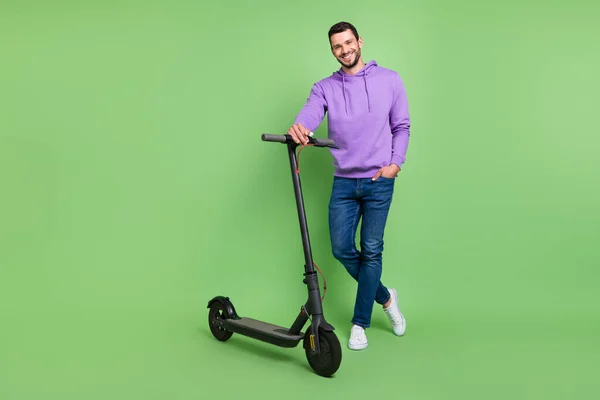
Once you have your scooter, the next step is gearing up for safety and mastering essential riding techniques. Safety gear, including helmets, knee pads, and elbow guards, is vital to protect yourself from potential accidents. After gearing up, it's time to focus on the core skills of scooter riding: balancing and braking.
These fundamental skills form the foundation of safe and efficient scooter riding. Throughout this guide, we'll provide you with detailed instructions and tips on 'how to ride a scooter,' maintain balance, use brakes effectively, and maneuver your scooter with ease. By the end of this article, you'll be well-equipped with the knowledge and techniques needed for a fun and responsible scooting adventure.
Choosing the Right Scooter for You
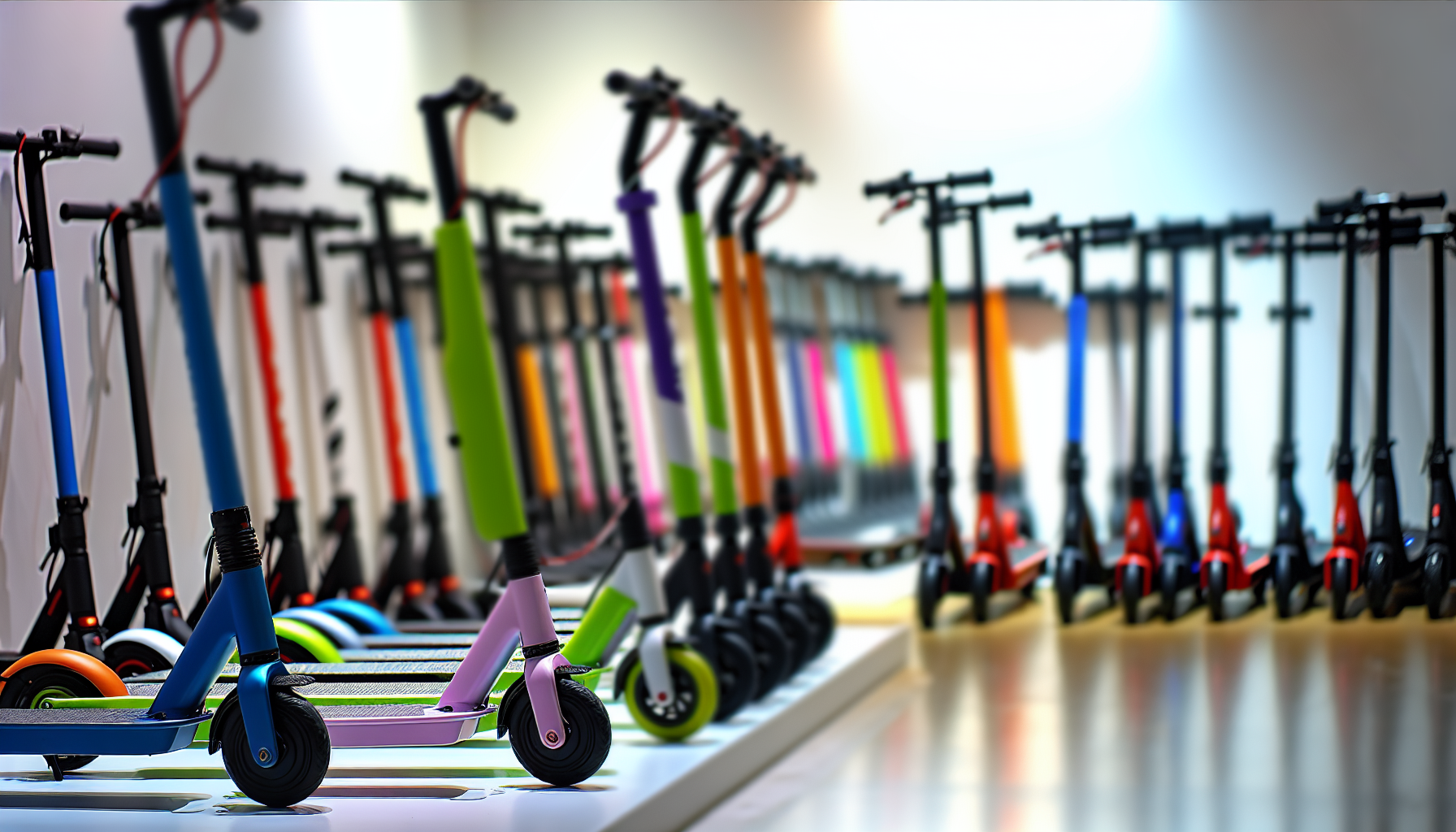
The first step in scooter riding is selecting the appropriate ride. Picture yourself on a sleek, electric scooter, zipping through urban areas or a rugged off-roader, tackling the wild. Your choice depends on your budget, your riding style, and what you’ll use it for. From commuting to trail busting, there’s a perfect scooter for every rider.
Ensuring a proper fit is crucial. Ever tried driving with your forehead touching the windshield? Not fun, right? The same goes for scooters. Your height and weight play a big role in your comfort and stability on a scooter. Scooters are not one-size-fits-all, so finding the right fit is key for safe and enjoyable rides.
Assessing Scooter Types
It’s time to explore different types of scooters. Here are some options to consider:
Kick scooters: Kick scooters are the quintessential choice for those looking for a simple, efficient mode of transport. They are characterized by their lightweight design, making them easy to carry and navigate through busy sidewalks or park paths.
Ideal for short commutes or as a fun way to enjoy the outdoors, kick scooters require physical effort to propel forward, offering a mild workout. They are also an excellent option for those conscious of their environmental footprint, as they don't emit any pollutants.
The simplicity of their design ensures low maintenance, and they are often more affordable than their motorized counterparts.
Electric scooters: Electric scooters have gained immense popularity as an eco-friendly alternative to motor vehicles. They are powered by rechargeable batteries, eliminating the need for fuel and making them silent yet efficient.
Electric scooter is perfect for longer commutes where manual effort isn't practical. They come in various speeds and designs, catering to both casual riders and those seeking more power and range. While they require charging, many models offer impressive distances on a single charge.
They are an excellent choice for urban commuters looking to avoid traffic, reduce carbon emissions, and enjoy a smooth, effortless ride.
Motorized scooters: For those seeking an adventurous ride, motorized scooters are the heavy-duty option. These scooters are designed to handle more challenging terrains, making them suitable for off-road adventures as well as urban environments.
They are equipped with powerful engines, offering greater speed and endurance compared to kick and electric scooters. This makes them ideal for longer distances and varied landscapes. However, they are typically heavier and may require a license and insurance, depending on your region's regulations.
They are a great pick for thrill-seekers or those who want a robust, versatile mode of transportation.
Each type has its perks, so choose the one that suits your needs best.
So, what’s your style?
Importance of Proper Fit
Securing the right fit can be equated to finding that perfect pair of jeans. Too tight or too loose? No thank you. The same goes for your scooter. The handlebar height should be around your waist or belly button for comfort, stability, and safety.
Also, ensure you examine the weight limit of your chosen scooter—it should easily accommodate your weight.
Essential Gear for Scooter Safety

Scooter riding can feel as exhilarating as starring in your own action movie. And every hero needs their armor. That’s where essential safety protective gear comes in. Think of your helmet as your crown, a symbol of your commitment to safety. It protects your head and looks stylish while doing it. And did we mention it’s mandatory in some places?.
But don’t stop at the helmet. Your body needs protection too. Especially if you’re a scooter newbie or a young rider, wearing pads, wrist guards, and elbow pads can save you from bumps, bruises, and scrapes. After all, every superhero wears a full suit, not just a crown.
Head Protection: Choosing a Helmet
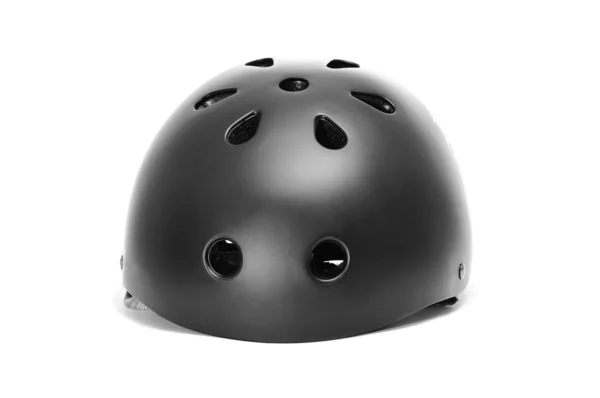
Choosing the right bike helmet is like choosing the right scooter, it needs to fit. Your helmet should meet safety standards, have good ventilation, and be practical for your riding style. It’s not just a fashion statement, it’s your first line of defense against serious injuries, especially head injuries.
So, make sure to pick a helmet that is just right for you.
Body Armor: Pads and Guards
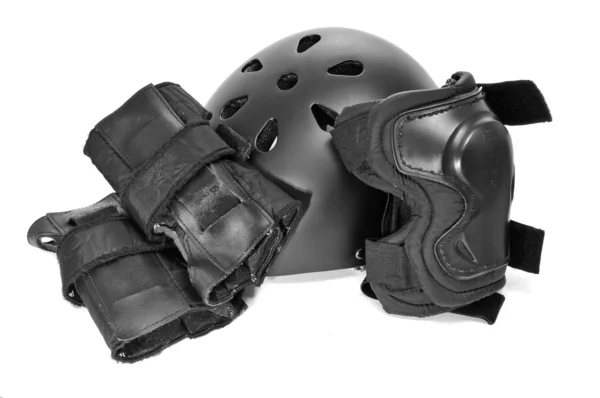
It’s time to equip the rest of your body with protective gear. Here are some options to consider:
-
Lightweight body armor
-
Knee pads
-
Elbow guards
-
Wrist guards
Investing in quality gear from trusted brands like Bluegrass can provide you with maximum protection.
Remember, a true scooter rider embraces safety in style while riding their kick scooter, just like most scooters on the market prioritize safety features and proper safety gear to ensure they ride safely.
Getting Started: Positioning and Posture
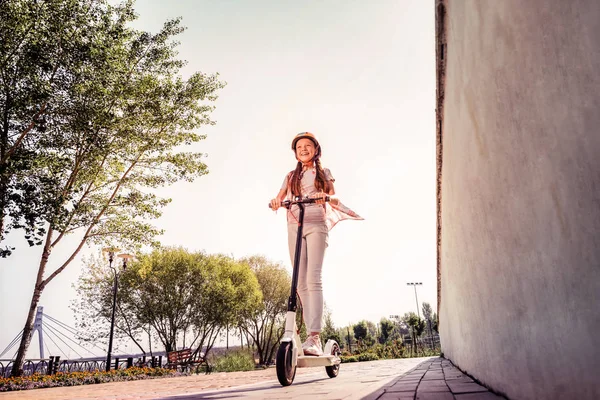
With your scooter and gear ready, you’re all set to start. Positioning and posture play a vital role in your scooter journey. Just like in dancing, your stance determines your balance and control. Stand with your dominant foot at the back of the scooter deck and your non-dominant foot at the front. This stance, whether regular or ‘goofy’, sets you up for success.
While foot placement is important, what about the positioning of the rest of your body? Relax your body, keep your arms loose, and your eyes on the road. Remember, stiff and tense riders are like rigid trees when it comes to riding scooters, more likely to fall in the wind. So, loosen up and let your body flow with the ride.
Finding Your Dominant Foot
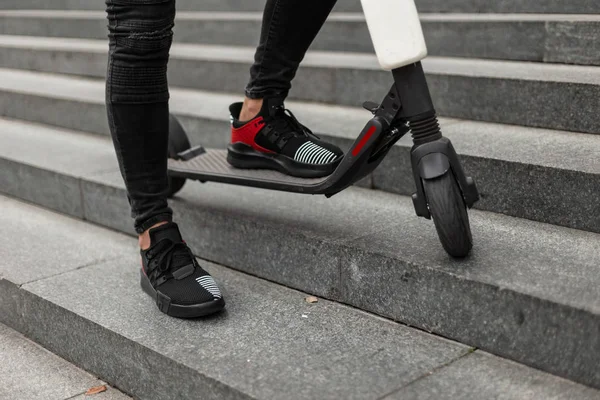
But wait, how do you know which foot is dominant? Think of the foot you naturally use to kick a ball or step forward when you stumble. Still confused? Try the ‘falling’ test. Stand straight, close your eyes, and have someone gently push you forward. The first foot you use to steady yourself, usually just one foot, is your dominant foot.
The Right Stance for Stability
Your dominant foot is your scooter’s power source. Place it at the back of the scooter deck, near the rear wheel, while your non-dominant foot stays at the front wheel. This foot placement distributes your weight evenly across the scooter, keeping you stable and balanced.
Remember, maintaining proper tire pressure is key to a smooth and safe ride along a straight line.
The Mechanics of Scooter Riding
Having mastered the basics, it’s time to delve into the mechanics of scooter riding. Picture yourself as a human engine, pushing off the ground with your dominant foot and cruising on your two wheels, with one being the front wheel. Sounds exciting, right? But remember, scooting is not just about speed; it’s also about control at higher speeds. Steering, turning, and braking are all part of the ride.
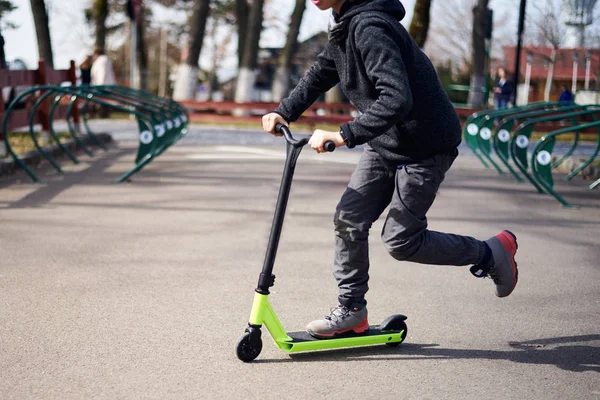
Steering a scooter shares similarities with navigating through life, encompassing both planned routes and unexpected detours. Use your handlebars to control your direction, lean into your turns, and always keep an eye on the road ahead to ensure you don’t lose control.
Conversely, braking primarily concerns safety. It’s knowing when to slow down and stop to avoid potential dangers. Always use both the front and rear brake levers together for a smooth and safe stop. And remember, practice makes perfect.
Pushing Off and Gaining Momentum
Pushing off is your scooter’s starter button. Here’s how to do it:
-
Position your dominant foot at the back of the scooter deck.
-
Push off the ground with your other foot.
-
Once you’ve gained momentum, place your pushing foot onto the scooter deck.
-
And voila! You’re gliding!
Remember, pushing off requires balance and coordination.
With consistent practice, you’ll soon be expertly maneuvering your scooter.
Steering and Turning
Steering and turning might seem intimidating at first, but with a bit of practice, you’ll be weaving through obstacles like a pro. To steer, simply turn your handlebars in the direction you want to go. For turning at higher speeds, you’ll need to use countersteering. Don’t worry, it’s not as complicated as it sounds. Simply push the handlebar in the opposite direction of the turn. Reiteration leads to perfection, so remember to keep practicing.
Mastering the Brakes
Consider your brakes as your most reliable companion on the road. They’re there to slow you down and bring you to a safe stop. To brake effectively, apply both the front brake and the rear brake evenly. This will prevent you from skidding or losing control.
Remember, mastering the brakes takes time and practice, but it’s essential for a safe scooter ride.
Practicing Safe Scooter Habits
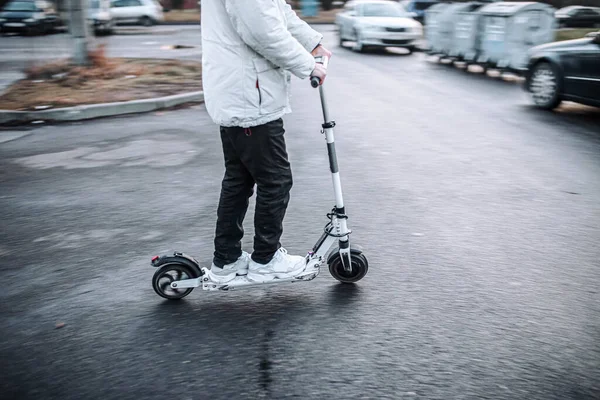
Although scooter riding is an efficient means of transportation, it comes with its own set of regulations, akin to any other mode of transport. From traffic laws to sharing the road, practicing safe scooter habits is key to a smooth and enjoyable ride. So, let’s talk safety.
First and foremost, familiarize yourself with the traffic laws. Whether it’s speed limits, helmet regulations, or designated areas for riding, staying on the right side of the law ensures a safe and hassle-free ride. And remember, these laws are not just guidelines, they’re there for your safety. Some important traffic laws to keep in mind include:
-
Obeying speed limits
-
Wearing a helmet
-
Using designated bike lanes or paths
-
Yielding to pedestrians
-
Following traffic signals and signs
Additionally, it's crucial to wear proper safety gear, including a helmet and proper shoes, when you're out biking. By following these laws and wearing the right gear, you can ensure a safe and enjoyable biking experience.
While sharing the road with cars and motorcycles might seem intimidating, there’s no need for undue concern. Just be visible, signal your intentions, and always maintain a safe distance from other vehicles. After all, the road is big enough for everyone.
Navigating Through Traffic Laws
Traffic laws can vary from place to place. Here are some examples:
-
In some places, scooter speed limits may be as high as 25 km/h, while in others, it could be as low as 20 km/h.
-
Helmet laws also vary. In some places, only riders under 18 need to wear a helmet, while in others, it’s mandatory for all, and in certain regions, wearing a full face helmet is specifically required.
-
When it comes to parking and riding, most cities have a parking lot and guidelines.
So, always be aware of the local laws where you’re riding.
Sharing the Road: Cars and Motorcycles
Sharing is caring, especially on the road. When sharing the road with cars and motorcycles, remember to:
-
Highlight your presence with high-visibility gear and reflective tape
-
Use hand signals to communicate your intentions
-
Always maintain a safe distance from other vehicles
Remember, safe road sharing is the responsibility of every road user.
Advanced Scooter Techniques
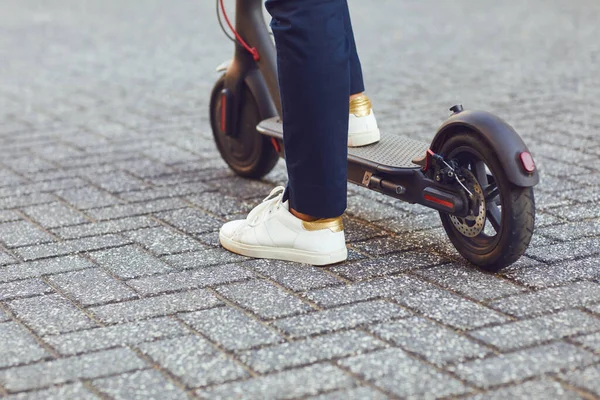
Are you prepared to elevate your scooter skills? Advanced scooter techniques can enhance your riding experience and make you a more confident rider. From quick stops to agile maneuvering, these techniques can transform your ride from basic to brilliant.
Executing quick stops revolves around maintaining control. It’s the ability to stop your scooter quickly and safely in an emergency. Likewise, agile maneuvering is about smoothly navigating through obstacles and tight spaces. So, whether you’re dodging a pothole or hopping over a small barrier, these techniques can make your ride safer and more fun.
Quick Stop Mastery
Mastering the quick stop can be a lifesaver in emergency situations. It’s all about shifting your weight and applying both brakes effectively. Close the throttle, pull in the clutch, and apply both brakes, including the front brake, evenly and firmly without locking them.
Remember to practice this technique in a safe environment, such as a parking lot, before taking it to the streets.
Agile Maneuvering
Agile maneuvering can be likened to performing a dance on wheels. It requires balance, coordination, and a keen awareness of your surroundings. From avoiding obstacles to hopping over small barriers, agile maneuvering can help you navigate through tight spaces with ease.
Practice makes perfect, so keep practicing these moves until they become second nature.
Maintaining Your Scooter
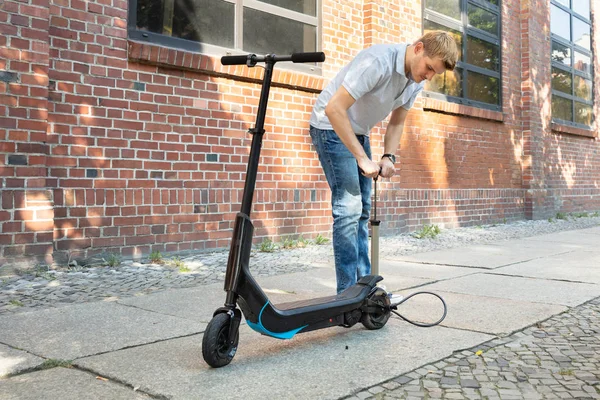
A scooter in good condition leads to a delightful riding experience. Regular check-ups, cleaning, and proper storage can ensure your scooter performs at its best and lasts a long time. Just like you need regular health checks, so does your scooter. After all, prevention is better than cure.
During check-ups, you should inspect components such as the tires, brakes, and for electric scooters, the battery life. Regularly cleaning your scooter, particularly after riding in damp conditions, can help prevent rust formation and potential damage. As for storage, keeping your scooter in a cool, dry place is the most ideal.
Regular Check-Ups
Consistent check-ups are instrumental in maintaining your scooter’s optimal condition. Inspect the tires for wear and check the brake caliper and disc for any damage or misalignment. For electric scooters, don’t forget to check the battery’s charge level.
Regular inspections can help you spot and fix issues before they become major problems. So, keep an eye on your scooter’s health.
Cleaning and Storage
After an enjoyable ride, it’s beneficial to clean your scooter thoroughly as part of its TLC. Use a soft, damp cloth to wipe down your scooter, especially after riding in wet or muddy conditions.
Regarding storage, locate a cool, dry spot to store your scooter when it’s not in use. Proper storage can prevent damage and extend the life of your scooter.
Always bear in mind that a clean scooter equates to a joyous ride.
Conclusion
The world of scootering is more than just a means of transportation; it's a gateway to adventure, a reflection of your personal style, and an incredibly enjoyable activity that combines fun, fitness, and freedom. Whether you're gliding through city streets on a sleek electric scooter, navigating a scenic path with a kick scooter, or embarking on an off-road journey with a motorized scooter, each ride is a unique experience filled with excitement.
As you embark on your scooter journey, remember the importance of safety and responsible riding. Always wear appropriate gear, be mindful of your surroundings, and respect traffic rules. Scootering offers a unique blend of convenience and enjoyment, making it an ideal choice for people of all ages and lifestyles.
So, embrace the thrill of the ride, the wind in your hair, and the freedom under your feet. Gear up, stay safe, and let the world be your playground as you keep scooting into new adventures and experiences!
Frequently Asked Questions
Is it easy to ride a scooter?
Riding an electric scooter is relatively easy to learn, especially if you're a beginner. Just remember to wear a helmet, practice, and gain confidence before riding in traffic, keeping one foot on the scooter at all times.
Can you ride a scooter for the first time?
Yes, you can ride a scooter for the first time, but it may be challenging at first. With practice, you'll eventually get the hang of it and it will become easier.
How to ride a moped?
To ride a moped, you should sit on a regular seat, keep both hands on the handle grips, and ride on the right edge of the road when possible. Also, make sure all moped equipment is in good working order. Safe travels!
How do I choose the right scooter for me?
Consider your budget, style in ride, and the scooter's fit for your height and weight to choose the right scooter for you. Good luck!
Why do I need to wear a helmet when riding a scooter?
You need to wear a helmet when riding a scooter because it reduces the risk of head injuries in case of an accident. Stay safe out there!
